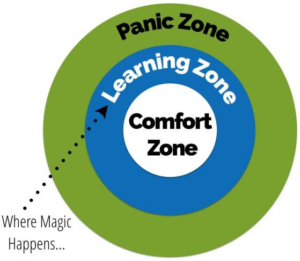Accept challenge! Struggle is good!
 The bull’s eye diagram certainly generates discussion:
The bull’s eye diagram certainly generates discussion:
- comfort zone: the student can already do the target learning tasks without help;
- panic zone: the student cannot do the target learning tasks; and
- learning zone: (aka. Vygotsky’s zone of proximal development) the student can do the target learning tasks with help.
First, teachers need to understand their learners. Start with diagnostic assessments¹ to determine where on the target that the learning tasks initially fall. Respecting neurodiversity, teachers should anticipate differences among learners and this insight should be used to plan how the learning is to be achieved.
Second, learning zone tasks require scaffolding, a boost or assist so that the learner may extend their learning and making progress. Monitor progress and use formative assessments¹ to inform adjustments to learning or corrections along the way.
Third, summative evaluations¹ confirm the extent to which that the learner has made progress, given their starting point — the difference between their starting point and where they are now.
| Students may exhibit uncertainty avoiding² behaviours and a fixed midset, (e.g. arms folded, rocking back and forth in their chair refusing to do the assigned work). What then? |
| Use scaffolding — give students the tools to shape their behaviours to become uncertainty tolerant adopting a growth mindset by: (a) teaching them to make reasonable assumptions; (b) to use problem solving processes (e.g., G*R*A*S*S); and, (c) to understand that we learn much from failure and errors. |
Finally, teachers should understand that student task choice can backfire. For example, an uncertainty avoiding student motivated by grade achievement might choose tasks that he/she can already ace — they are already comfortable with the chosen task. In this case, no progress is made, no net new learning results. Instead, encourage students to choose challenging tasks, as the American President John F. Kennedy did when posing a national challenge to land men on the moon and return them safely back to Earth.
¹ Note the language related to assessment vs. evaluation. Diagnostic and formative assessments are informational and indicate the state of student learning at the beginning and during learning, respectively. Summative evaluations — or simply evaluations — are a measure of the final state of learning (and are included in the student grade.) Though commonly used both as a noun and as a verb, summative is redundant; evaluation will do nicely.
² Click here for more on uncertainty avoidance as one of six dimensions of school culture.